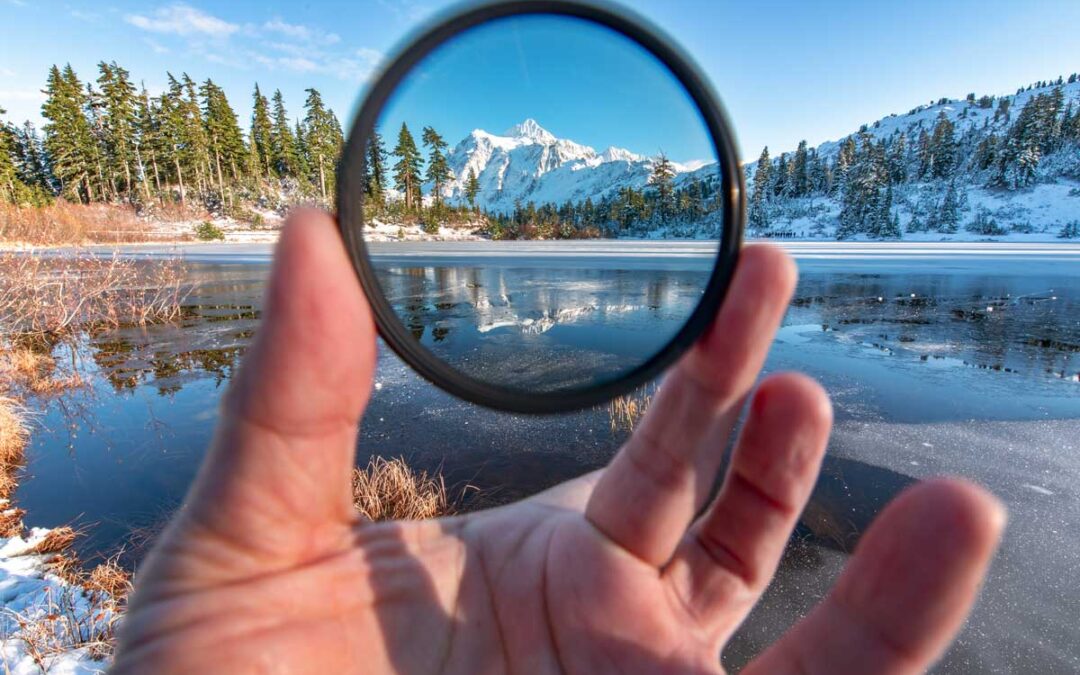Photography, like many visual arts, depends greatly on the manipulation of light to create compelling images. One tool that has proven invaluable in this endeavor is the polarizing filter. This article will delve into the depths of the polarizing filter’s functionality, illustrating its significance in fine art photography and beyond. We will also shed light on when not to use this tool, offering a comprehensive understanding for every Texas photographer and worldwide.
Decoding Polarizing Filters
A polarizing filter, also known as a polarizer, is an optical filter that photographers use to manage light in their images. The filter can enhance colors, reduce glare and reflections from surfaces, and intensify the blue hues in skies. By altering the way light interacts with your camera, a polarizing filter can drastically change the appearance of an image.
A polarizer is an indispensable tool in the toolbox of any serious photographer, and it’s particularly loved by those engaged in landscape and fine art photography. This is because it can reveal details and colors that would otherwise be hidden by glare or reflections. However, as with any tool, it’s essential to understand when and how to use it correctly.
How Polarizing Filters Function
Light travels in waves, scattering in various directions. When it bounces off certain surfaces like water, glass, or atmospheric particles, it becomes polarized. This means the light waves align along a specific plane, causing glare, reflections, and a decrease in color saturation.
A polarizing filter manipulates this polarized light, separating it from the non-polarized light. By rotating the filter, you can adjust the level of polarization, hence controlling the amount of reflection and color saturation in your image.

Types of Polarizing Filters: Linear vs. Circular
Polarizing filters are available in two main types: linear and circular. These names, however, do not refer to the shape of the filters, but to the manner in which they manipulate light.
Linear polarizing filters have one polarizing layer. They are less expensive but can interfere with the autofocusing and metering capabilities of modern digital cameras.
On the other hand, circular polarizing filters (CPLs) contain two layers. The second layer, known as a quarter-wave plate, repolarizes the light that passes through the first layer. This process prevents interference with camera functions, making CPLs more effective, albeit pricier.

The Trade-off: Light Loss
While CPLs are excellent at enhancing colors and reducing glare, they do have a downside: they reduce the total amount of light reaching the camera’s sensor. This means you may need to adjust your camera settings to compensate for this light loss, potentially increasing your aperture or ISO settings, which can impact the depth of field and introduce noise into your images.
Polarizers vs. Neutral Density Filters
At this point, you might be wondering if a CPL, which reduces light, could also function as a neutral density (ND) filter. The answer is yes, but with a caveat. While a CPL can indeed reduce the amount of light entering the camera, it does not affect all light equally like an ND filter does. Therefore, while it can assist in controlling exposure in bright conditions, it may not be as effective as an ND filter in this regard.
Benefits of Polarizing Filters: Use Cases
Polarizing filters are a boon when you want to minimize glare or reflections from certain surfaces like water, glass, or shiny leaves. They can help make your subjects stand out more clearly, without distractions from unwanted reflections. Moreover, polarizing filters can intensify the colors in your scene by reducing direct reflections, an effect that is particularly noticeable on bright sunny days.
Let’s delve into a few scenarios where a polarizer can make all the difference:
Intensifying Color Saturation
One of the primary uses of a polarizer is to enhance color saturation. When shooting landscapes, for instance, a polarizer can make the colors more vibrant, giving your images a more dramatic and appealing look. This is particularly true when shooting in natural light, where the filter can intensify the blue of the sky or the green of the foliage.
Reducing Glare and Reflections
Polarizers are also incredibly useful for reducing glare and reflections on non-metallic surfaces. This can make a significant difference when photographing bodies of water, wet surfaces, or glass. By minimizing reflections, a polarizer allows the true colors and details of these surfaces to come through, enhancing the overall quality of the image.
Enhancing Contrast
By reducing haze and reflections, a polarizer can help enhance the contrast in your images. This is particularly useful in landscape photography, where the filter can help distinguish between different elements in the scene, bringing out the details in the clouds or the textures in the foliage.
Disadvantages of Polarizers: When to Avoid Them
Despite their numerous benefits, polarizing filters are not always the best choice for every situation. Here are a few instances where you might want to avoid using them:
Low Light Conditions
As previously mentioned, a polarizing filter reduces the amount of light that reaches the camera’s sensor. This can be an issue in low-light situations, where you might need all the light you can get. So, if you’re shooting during the blue hour, at night, or in heavily shaded areas, it might be best to remove the polarizer.
When You Want Reflections
While a polarizer is great for reducing reflections, there might be times when you want to capture those reflections. For instance, if you’re shooting a landscape with a calm lake, you might want to capture the reflection of the sky or the surrounding scenery on the water’s surface. In such cases, using a polarizer would reduce the intensity of the reflections, potentially diminishing the impact of your image.
When Shooting Rainbows
Rainbows are formed by the reflection, refraction, and dispersion of light in water droplets. Using a polarizer when shooting a rainbow can reduce its visibility, making it appear less vibrant. So, if you’re trying to capture a beautiful rainbow, it’s best to do it without a polarizer.
When Shooting Wide-Angle Scenes
Using a polarizer when shooting with a wide-angle lens can sometimes result in an uneven effect across your scene, with some parts appearing darker than others. This is because the angle of the sun to your camera can vary across the wide field of view, resulting in different degrees of polarization.
Polarizing Filters: A Timeless Asset in Photography
Polarizing filters have been around since 1938, and their popularity among photographers has not waned. These filters can significantly improve your images by enhancing colors, reducing glare, and improving contrast. However, it’s essential to understand when to use them and when not to.
Despite the few situations where a polarizer might not be the best choice, its benefits far outweigh its drawbacks. So, whether you’re a seasoned professional or an aspiring Texas photographer, a polarizing filter is a worthy investment for your photography toolkit.
Wrapping Up: To Use or Not to Use?
Ultimately, the decision to use a polarizing filter boils down to the specific requirements of the scene you’re shooting and the effect you’re aiming to achieve. By understanding the workings of a polarizer and the situations where it can either enhance or detract from your image, you can make an informed decision on when to use this powerful tool.
Remember, photography is as much an art as it is a science. Experimentation is key. Don’t hesitate to try shooting the same scene with and without a polarizer to see which result you prefer. After all, every photograph is a unique expression of your creative vision.
As we delve into the nuances of photography, it’s clear that a polarizing filter can be a game-changer, transforming ordinary shots into extraordinary works of art. Whether you’re a fine art photography enthusiast or a dedicated Texas photographer, mastering the use of polarizing filters can surely elevate your craft.


